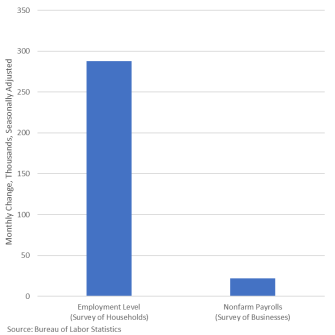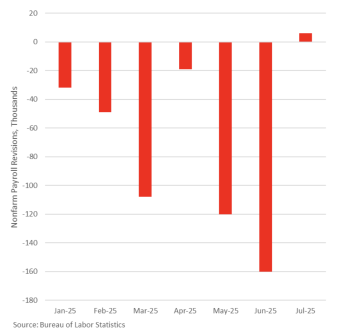
the staff of the Ridgewood blog
Washington DC, , are the U.S. job numbers you hear about each month reliable? A growing chorus of experts says no, and the latest Bureau of Labor Statistics (BLS) reports prove it. With massive discrepancies between surveys, nearly 500,000 downward revisions, and a looming benchmark adjustment that could slash over half a million jobs from past estimates, the BLS is under fire. Is it time for a major overhaul led by E.J. Antoni? Let’s unpack why the jobs data is raising red flags and what it means for the economy.

The Jobs Report Mismatch: 22,000 vs. 288,000 Jobs in August 2025
The BLS relies on two key surveys to gauge U.S. job growth: the establishment survey (survey of firms) and the household survey. For August 2025, these surveys told wildly different stories. The establishment survey reported a meager 22,000 net new jobs, signaling a bearish outlook and a cooling labor market. Meanwhile, the household survey estimated a bullish 288,000 new jobs—a number that paints a far rosier picture.
So, which is right? The massive gap—over 260,000 jobs—highlights a fundamental issue with the BLS’s data collection. This isn’t just a one-off problem; it’s part of a troubling pattern that’s eroding trust in these critical economic indicators.

Massive Downward Revisions: Nearly 500,000 Jobs Erased
This week’s jobs revisions report added fuel to the fire. The BLS revised down its previous job growth estimates by nearly 500,000 jobs from the original headline numbers. For context, June 2025 alone saw a revision of 27,000 fewer jobs, with the month flipping from a reported gain of 14,000 to a net loss of 13,000—the first decline since late 2020. These revisions aren’t minor tweaks; they’re seismic shifts that undermine confidence in the data used by policymakers, businesses, and investors.
A Looming Benchmark Revision Could Make Things Worse
If that wasn’t enough, the BLS is set to release its annual benchmark revision in just a few days, and experts estimate it could slash reported job growth by over 500,000 jobs. This follows a troubling trend: last year, the BLS revised down payroll growth for the year ending March 2024 by a staggering 818,000 jobs—the second-largest benchmark revision on record. These persistent inaccuracies have far-reaching consequences, from misleading Federal Reserve policy to confusing businesses planning their hiring strategies.
Why the BLS Data Keeps Falling Short
The problems at the BLS aren’t new. Issues with methodology, economic modeling, and statistical assumptions have plagued the agency for at least three years, and many argue they’re getting worse. E.J. Antoni, a Heritage Foundation economist nominated by President Trump to lead the BLS, has called the monthly jobs data “fundamentally flawed” and even suggested pausing the reports until the issues are fixed. Without accurate numbers, how can the Federal Reserve set interest rates or businesses plan for growth?
The Case for E.J. Antoni to Fix the BLS
The nomination of E.J. Antoni to head the BLS has sparked intense debate. Supporters, including Trump, argue that Antoni’s critical eye and commitment to accuracy make him the right person to restore trust in the agency. Critics, however, worry about politicization, given Antoni’s vocal skepticism of current BLS methods. Regardless, the Senate faces pressure to confirm him swiftly to address the agency’s ongoing failures and deliver reliable data.
Why Accurate Jobs Data Matters
Trustworthy jobs numbers are the backbone of economic decision-making. The Federal Reserve uses them to set monetary policy, businesses rely on them to plan hiring, and families use them to gauge job-hunting prospects. When the data is unreliable, it creates uncertainty that ripples across the economy. With the labor market showing signs of stalling—August’s 22,000 jobs fell far short of the expected 75,000—it’s more critical than ever to get this right.
Time for a BLS Overhaul?
The evidence is mounting: the Bureau of Labor Statistics is failing to deliver the accurate, reliable jobs data America needs. From conflicting surveys to massive revisions and an impending half-million-job correction, the system is broken. As the Senate considers E.J. Antoni’s confirmation, the question remains: Can the BLS be fixed, or is a complete rethink of how we measure jobs in order? Share your thoughts in the comments below.
Gusto is a payroll and HR software that helps you pay your team, file taxes, offer benefits, and more. See how Gusto compares to other providers, get a free trial, and learn how to switch to Gusto in minutes.
https://gusto.com/i/james3539

Why does the BLS Survey get poor results?
Because instead of asking simple questions that could be easily answered, the bureaucrats have decided they need to ask you pages and pages of questions.
That’s why I hit the delete button.
Me too.
That’s a lot of word salad from someone who obviously doesn’t understand sampling and statistical analysis.
Here’s more salad for you:
The Bureau of Labor Statistics (BLS) published its first estimate of the annual benchmark revision, which lowered its estimate of employment by about 911,000 jobs over the April 2024 to March 2025 period.
BLS goes through the benchmarking process each year to incorporate more accurate data from state unemployment records that are published quarterly along with business birth and death records into its estimates.
The process yields a more complete and accurate picture of the labor market than the agency’s monthly surveys that are used to create the jobs report, and serves as a means of mitigating the non-response and reporting errors that accumulate month-to-month.